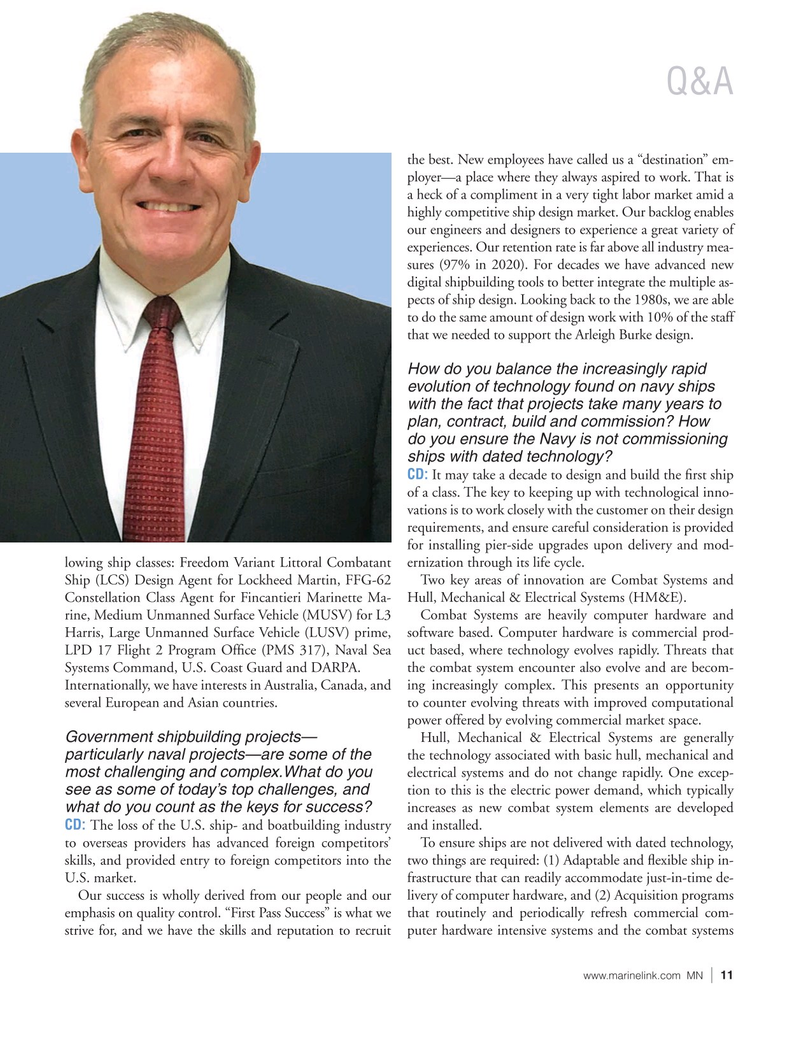
Page 11: of Marine News Magazine (June 2021)
Combat & Patrol Craft
Read this page in Pdf, Flash or Html5 edition of June 2021 Marine News Magazine
Q&A the best. New employees have called us a “destination” em- ployer—a place where they always aspired to work. That is a heck of a compliment in a very tight labor market amid a highly competitive ship design market. Our backlog enables our engineers and designers to experience a great variety of experiences. Our retention rate is far above all industry mea- sures (97% in 2020). For decades we have advanced new digital shipbuilding tools to better integrate the multiple as- pects of ship design. Looking back to the 1980s, we are able to do the same amount of design work with 10% of the staff that we needed to support the Arleigh Burke design.
How do you balance the increasingly rapid evolution of technology found on navy ships with the fact that projects take many years to plan, contract, build and commission? How do you ensure the Navy is not commissioning ships with dated technology?
CD: It may take a decade to design and build the ? rst ship of a class. The key to keeping up with technological inno- vations is to work closely with the customer on their design requirements, and ensure careful consideration is provided for installing pier-side upgrades upon delivery and mod- lowing ship classes: Freedom Variant Littoral Combatant ernization through its life cycle.
Ship (LCS) Design Agent for Lockheed Martin, FFG-62 Two key areas of innovation are Combat Systems and
Constellation Class Agent for Fincantieri Marinette Ma- Hull, Mechanical & Electrical Systems (HM&E).
rine, Medium Unmanned Surface Vehicle (MUSV) for L3 Combat Systems are heavily computer hardware and
Harris, Large Unmanned Surface Vehicle (LUSV) prime, software based. Computer hardware is commercial prod-
LPD 17 Flight 2 Program Of? ce (PMS 317), Naval Sea uct based, where technology evolves rapidly. Threats that
Systems Command, U.S. Coast Guard and DARPA. the combat system encounter also evolve and are becom-
Internationally, we have interests in Australia, Canada, and ing increasingly complex. This presents an opportunity several European and Asian countries. to counter evolving threats with improved computational power offered by evolving commercial market space.
Hull, Mechanical & Electrical Systems are generally
Government shipbuilding projects— the technology associated with basic hull, mechanical and particularly naval projects—are some of the electrical systems and do not change rapidly. One excep- most challenging and complex.What do you tion to this is the electric power demand, which typically see as some of today’s top challenges, and increases as new combat system elements are developed what do you count as the keys for success?
CD: The loss of the U.S. ship- and boatbuilding industry and installed.
to overseas providers has advanced foreign competitors’ To ensure ships are not delivered with dated technology, skills, and provided entry to foreign competitors into the two things are required: (1) Adaptable and ? exible ship in-
U.S. market. frastructure that can readily accommodate just-in-time de-
Our success is wholly derived from our people and our livery of computer hardware, and (2) Acquisition programs emphasis on quality control. “First Pass Success” is what we that routinely and periodically refresh commercial com- strive for, and we have the skills and reputation to recruit puter hardware intensive systems and the combat systems www.marinelink.com MN 11|

 10
10

 12
12
